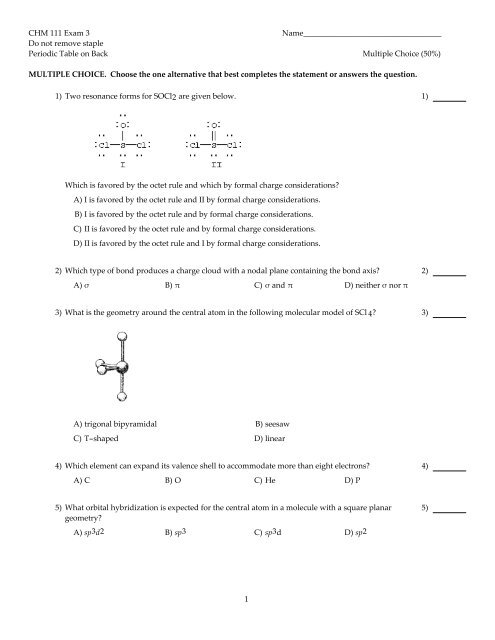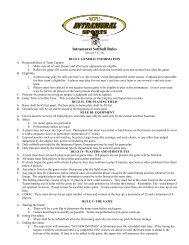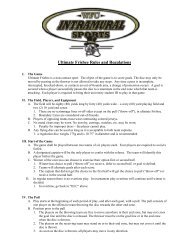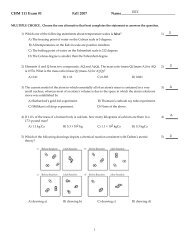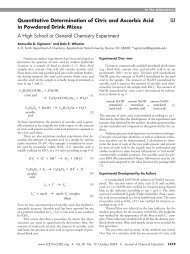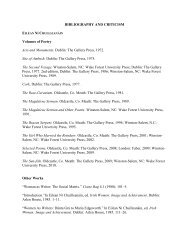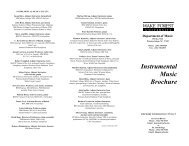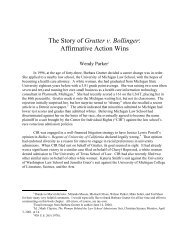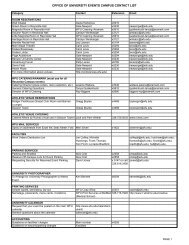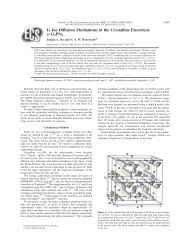PE3b.pdf
PE3b.pdf
PE3b.pdf
Create successful ePaper yourself
Turn your PDF publications into a flip-book with our unique Google optimized e-Paper software.
CHM 111 Exam 3 Name___________________________________<br />
Do not remove staple<br />
Periodic Table on Back Multiple Choice (50%)<br />
MULTIPLE CHOICE. Choose the one alternative that best completes the statement or answers the question.<br />
1) Two resonance forms for SOCl2 are given below.<br />
Which is favored by the octet rule and which by formal charge considerations?<br />
A) I is favored by the octet rule and II by formal charge considerations.<br />
B) I is favored by the octet rule and by formal charge considerations.<br />
C) II is favored by the octet rule and by formal charge considerations.<br />
D) II is favored by the octet rule and I by formal charge considerations.<br />
2) Which type of bond produces a charge cloud with a nodal plane containing the bond axis?<br />
A) σ B) π C) σ and π D) neither σ nor π<br />
3) What is the geometry around the central atom in the following molecular model of SCl 4?<br />
A) trigonal bipyramidal B) seesaw<br />
C) T-shaped D) linear<br />
4) Which element can expand its valence shell to accommodate more than eight electrons?<br />
A) C B) O C) He D) P<br />
5) What orbital hybridization is expected for the central atom in a molecule with a square planar<br />
geometry?<br />
A) sp3d2 B) sp3 C) sp3d D) sp2<br />
1<br />
1)<br />
2)<br />
3)<br />
4)<br />
5)
6) A triple bond is generally composed of<br />
A) three π bonds. B) three σ bonds.<br />
C) one π bond and two σ bonds. D) two π bonds and one σ bond.<br />
7) Which of the following would be expected to have sp2 hybridization on atom A?<br />
A) I and IV B) II C) I and III D) I, II, and III<br />
8) How many lone pairs of electrons are on the P atom in PF3?<br />
A) 2 B) 1 C) 0 D) 3<br />
9) Of the following elements, which has the lowest electronegativity?<br />
A) Mg B) Br C) Ca D) Cl<br />
10) What is the geometry around the central atom in the following molecular model of PF 6 -?<br />
A) trigonal bipyramidal B) octahedral<br />
C) square pyramidal D) square planar<br />
11) Which one of the following is expected to exhibit resonance?<br />
A) CO2 B) HCN C) NO2- D) NH4 +<br />
12) What is the molecular geometry of AsCl3?<br />
A) T-shaped B) trigonal planar<br />
C) tetrahedral D) trigonal pyramidal<br />
2<br />
6)<br />
7)<br />
8)<br />
9)<br />
10)<br />
11)<br />
12)
13) Which bond should have the longest length?<br />
A) N=N<br />
B) NN<br />
C) NN<br />
D) All three bond lengths should be about the same.<br />
14) What is the molecular geometry of IF5?<br />
A) trigonal bipyramidal B) seesaw<br />
C) octahedral D) square pyramidal<br />
15) Covalent bonding is a<br />
A) loss of electrons. B) transfer of electrons.<br />
C) gain of electrons. D) sharing of electrons.<br />
16) Which is the most acceptable electron dot structure for carbonyl fluoride, COF2?<br />
A) B)<br />
C) D)<br />
17) Which orbital hybridization is associated with a tetrahedral charge cloud arrangement?<br />
A) sp2 B) sp3d2 C) sp3 D) sp<br />
18) What is the geometry around the central atom in the following molecular model of PH3?<br />
A) linear B) bent<br />
C) trigonal pyramidal D) tetrahedral<br />
3<br />
13)<br />
14)<br />
15)<br />
16)<br />
17)<br />
18)
19) Which bond should have the highest bond dissociation energy?<br />
A) NN<br />
B) NN<br />
C) NN<br />
D) All three bonds should have about the same dissociation energy.<br />
20) Based on the indicated electronegativities, arrange the following in order of increasing ionic<br />
character: CsBr, LaBr3, PBr3, MgBr2.<br />
Element Electronegativity<br />
Br 2.8<br />
P 2.1<br />
Mg 1.2<br />
La 1.0<br />
Cs 0.7<br />
A) PBr3, LaBr3, MgBr2, CsBr B) CsBr, MgBr2, PBr3, LaBr3<br />
C) PBr3, MgBr2, LaBr3, CsBr D) CsBr, LaBr3, MgBr2, PBr3<br />
21) The electronegativity for both sulfur and carbon is 2.5. Therefore the compound CS 2 would be<br />
expected to<br />
A) be ionic with C as the cation.<br />
B) have polar covalent bonds between C and S.<br />
C) be ionic with C as the anion.<br />
D) have nonpolar covalent bonds between C and S.<br />
22) In the best Lewis structure for NO+, what is the formal charge on the N atom?<br />
A) 0 B) -1 C) +1 D) +2<br />
23) Assign formal charges to each atom in the resonance form for SOCl2 given below.<br />
A) -1 for Cl, -2 for S, and -2 for O B) -1 for Cl, +4 for S, and -2 for O<br />
C) 0 for Cl, 0 for S, and 0 for O D) 0 for Cl, +1 for S, and -1 for O<br />
4<br />
19)<br />
20)<br />
21)<br />
22)<br />
23)
24) What is the geometry around the central atom in the following molecular model of CCl 4?<br />
A) linear B) bent<br />
C) trigonal pyramidal D) tetrahedral<br />
25) Based on VSEPR theory, which should have the smallest XAX bond angle?<br />
A) B) C) D)<br />
5<br />
24)<br />
25)
CHM 111 Exam 3 Molecular Structure (50%)<br />
1. In the space below, draw all of the acceptable Lewis Structures for POF3 where P is the<br />
only central atom.<br />
2. Circle the most favored resonance form (or forms).<br />
3. Name the shape of POF3<br />
4. Give the hybridization for the P atom<br />
5. Which bond, if any, do you expect to be shortest? Explain.<br />
6
CHM 111 Exam 3 Name___________________________________<br />
Do not remove staple<br />
Periodic Table on Back Multiple Choice (50%)<br />
MULTIPLE CHOICE. Choose the one alternative that best completes the statement or answers the question.<br />
1) Two resonance forms for SOCl2 are given below.<br />
Which is favored by the octet rule and which by formal charge considerations?<br />
A) I is favored by the octet rule and II by formal charge considerations.<br />
B) I is favored by the octet rule and by formal charge considerations.<br />
C) II is favored by the octet rule and by formal charge considerations.<br />
D) II is favored by the octet rule and I by formal charge considerations.<br />
2) Which type of bond produces a charge cloud with a nodal plane containing the bond axis?<br />
A) σ B) π C) σ and π D) neither σ nor π<br />
3) What is the geometry around the central atom in the following molecular model of SCl 4?<br />
A) trigonal bipyramidal B) seesaw<br />
C) T-shaped D) linear<br />
4) Which element can expand its valence shell to accommodate more than eight electrons?<br />
A) C B) O C) He D) P<br />
5) What orbital hybridization is expected for the central atom in a molecule with a square planar<br />
geometry?<br />
A) sp3d2 B) sp3 C) sp3d D) sp2<br />
1<br />
1)<br />
2)<br />
3)<br />
4)<br />
5)
6) A triple bond is generally composed of<br />
A) three π bonds. B) three σ bonds.<br />
C) one π bond and two σ bonds. D) two π bonds and one σ bond.<br />
7) Which of the following would be expected to have sp2 hybridization on atom A?<br />
A) I and IV B) II C) I and III D) I, II, and III<br />
8) How many lone pairs of electrons are on the P atom in PF3?<br />
A) 2 B) 1 C) 0 D) 3<br />
9) Of the following elements, which has the lowest electronegativity?<br />
A) Mg B) Br C) Ca D) Cl<br />
10) What is the geometry around the central atom in the following molecular model of PF 6 -?<br />
A) trigonal bipyramidal B) octahedral<br />
C) square pyramidal D) square planar<br />
11) Which one of the following is expected to exhibit resonance?<br />
A) CO2 B) HCN C) NO2- D) NH4 +<br />
12) What is the molecular geometry of AsCl3?<br />
A) T-shaped B) trigonal planar<br />
C) tetrahedral D) trigonal pyramidal<br />
2<br />
6)<br />
7)<br />
8)<br />
9)<br />
10)<br />
11)<br />
12)
13) Which bond should have the longest length?<br />
A) N=N<br />
B) NN<br />
C) NN<br />
D) All three bond lengths should be about the same.<br />
14) What is the molecular geometry of IF5?<br />
A) trigonal bipyramidal B) seesaw<br />
C) octahedral D) square pyramidal<br />
15) Covalent bonding is a<br />
A) loss of electrons. B) transfer of electrons.<br />
C) gain of electrons. D) sharing of electrons.<br />
16) Which is the most acceptable electron dot structure for carbonyl fluoride, COF2?<br />
A) B)<br />
C) D)<br />
17) Which orbital hybridization is associated with a tetrahedral charge cloud arrangement?<br />
A) sp2 B) sp3d2 C) sp3 D) sp<br />
18) What is the geometry around the central atom in the following molecular model of PH3?<br />
A) linear B) bent<br />
C) trigonal pyramidal D) tetrahedral<br />
3<br />
13)<br />
14)<br />
15)<br />
16)<br />
17)<br />
18)
19) Which bond should have the highest bond dissociation energy?<br />
A) NN<br />
B) NN<br />
C) NN<br />
D) All three bonds should have about the same dissociation energy.<br />
20) Based on the indicated electronegativities, arrange the following in order of increasing ionic<br />
character: CsBr, LaBr3, PBr3, MgBr2.<br />
Element Electronegativity<br />
Br 2.8<br />
P 2.1<br />
Mg 1.2<br />
La 1.0<br />
Cs 0.7<br />
A) PBr3, LaBr3, MgBr2, CsBr B) CsBr, MgBr2, PBr3, LaBr3<br />
C) PBr3, MgBr2, LaBr3, CsBr D) CsBr, LaBr3, MgBr2, PBr3<br />
21) The electronegativity for both sulfur and carbon is 2.5. Therefore the compound CS 2 would be<br />
expected to<br />
A) be ionic with C as the cation.<br />
B) have polar covalent bonds between C and S.<br />
C) be ionic with C as the anion.<br />
D) have nonpolar covalent bonds between C and S.<br />
22) In the best Lewis structure for NO+, what is the formal charge on the N atom?<br />
A) 0 B) -1 C) +1 D) +2<br />
23) Assign formal charges to each atom in the resonance form for SOCl2 given below.<br />
A) -1 for Cl, -2 for S, and -2 for O B) -1 for Cl, +4 for S, and -2 for O<br />
C) 0 for Cl, 0 for S, and 0 for O D) 0 for Cl, +1 for S, and -1 for O<br />
4<br />
19)<br />
20)<br />
21)<br />
22)<br />
23)
24) What is the geometry around the central atom in the following molecular model of CCl 4?<br />
A) linear B) bent<br />
C) trigonal pyramidal D) tetrahedral<br />
25) Based on VSEPR theory, which should have the smallest XAX bond angle?<br />
A) B) C) D)<br />
5<br />
24)<br />
25)
CHM 111 Exam 3 Molecular Structure (50%)<br />
1. In the space below, draw all of the acceptable Lewis Structures for POF3 where P is the<br />
only central atom.<br />
2. Circle the most favored resonance form (or forms).<br />
3. Name the shape of POF3<br />
4. Give the hybridization for the P atom<br />
5. Which bond, if any, do you expect to be shortest? Explain.<br />
6


